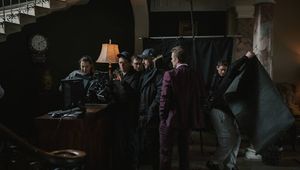
Banjoman Directors are Illuminating Change

Banjoman seems to have a bit of a running theme lately. Directors, Dermot and Duncan have recently completed projects for lrish energy provider, start-up UrbanVolt and powerhouse Electric Ireland. The spots themselves are something of a marvel; both displaying clearly each director's own idiosyncrasies. The common denominator between the two, however, is about injecting light into darkness. For Duncan, it’s in the form of laughter and unexpected friendships. For Dermot, it’s in the form of hope when things feel hopeless.
They both exemplify the place that the light stuff and the more heavy, have in advertising. It’s great when something makes you stop and think. That’s what each of these spots achieve in their own right - and much of that is down to how they’ve been directed.
In our conversation with Duncan and Dermot we found out about their experiences behind the scenes, and explored the importance of advertising in advocating for change.
The Electric Ireland ad follows a restless little boy named Charlie, whose freckled face sits huffing in his bedroom after being scolded by his mother. Across the street, his elderly neighbour notices his displeasure and decides to communicate with him by flashing her lights on and off. She clicks her fingers and upstairs lights up, blows air and so too does the room in its direction. They go back and forth before both uniting in a glorious chuckle. It’s a feel good piece that finishes with the message of, “making your world, brighter.”
For Duncan, it was important to communicate a message of community: “We live in such a busy world where it can feel like everyone is just going about their day, thinking about their own path, stuck in their own bubble. This can lead to people feeling isolated.” He explains that this is why we need to feel connected, now more than ever, “What are we if we don’t have each other?” says Duncan. The film shows the unexpected connection between two generations and by virtue, two very different people, “It gives us hope: we’re in this world together” he asserts.
Given that the film is set in two houses directly across the street from one-another, with a clear line of sight between each one, it was a challenge to find the perfect location. “In the end we actually came close and found two perfect houses, we just needed a little helping hand from our friends in post production to make them feel just a tiny bit closer together,” Duncan tells us, noting also the challenges of having a film set entirely at dusk. The team built a huge light box outside of each window to enable them to shoot into the rooms from outside and create an impression of dusk, despite it being shot during the day.
Paramount to spot was collaborating with creatives: “there was a real focus on building the characters and developing their arcs.” He describes how important it was that the boy wasn’t cheered up too quickly. His transformation from upset to delighted had to feel authentic and organic, “it was similar with our hero woman. We wanted to see her confidence grow as we went along.” The truly natural outcome was a product of an incredibly thorough casting process in the UK and Ireland. They knew from the outset that one of the biggest challenges would be getting the reactions from the boy - “this is always one of the biggest challenges when working with child actors: having them give a big reaction without them actually having anything to react to”. The answer to this here was having someone off camera for the boy to react to so that everything would feel as real as possible.
This endeavour really epitomises what Duncan wants to communicate through his directing. He’s committed to create films that resonate deeply with viewers, striking a chord of authenticity and sincerity. His respect for actors and the process of collaboration shines through too; this in turn allows them the latitude to breathe life into the subtlest of moments, fine-tuning the intricacies that magnify a character’s depth and elevate the narrative.
We also spoke to Dermot Malone about directing the new spot for UrbanVolt, “Move Forward”. The ad begins with two tones on a piano, followed by the voice of Sir Davos Seaworth asking, “What are we doing… to this beautiful place?” The scene is dark and the camera follows a young man from behind as he makes his way down the middle of the road before his body, buzzing with electricity, begins to dance. There are flashes of crumbling ice caps, forests burning, juxtaposing positive images as the message grows into one of hope rather than despair.
Interestingly, the spot was never meant to turn out the way it did. The client came with a different reference for what they wanted, in the form of a literal take on what the company does. Dermot pitched a slightly alternative take. After getting the go-ahead, Dermot sat down and wrote a new creative and script, where the dancer, Sean Hyland, would move through a barren landscape, capturing powerful thematic imagery. “This was symbolic of hope and progress,” says Dermot. He wrote the voiceover with the imagery in mind. “The movement through industrial wasteland, intercut with images of earth’s devastation and the beauty we’re fighting for” - he then worked to shape the voiceover to sync with the visuals, creating a symbiotic relationship between the two.
“Move Forward” would be Dermot’s first ever experience collaborating with a dancer. “Working directly with Sean, without a choreographer, was unchartered territory for me,” he admits. But the outcome, Dermot believes, was a rewarding one.
Transformative Power
Reflecting on the transformative power of media and advertising in advocating for sustainability, both directors highlight the imperative of storytelling. Duncan notes, “it’s one of the most powerful tools we have to inspire change.” Dermot echoes, emphasising its influential capacity, “I believe it’s crucial that it addresses this problem. Advertising can influence people’s decision-making… it has the power and reach to communicate effectively, perhaps even more than politicians and the media."
These two spots share the same focus on core ideas and storytelling, aiming to impact and connect emotionally with the audience. The essence remains consistent for Banjoman: harnessing the narrative strength of advertising can not only inform, but inspire collective action towards a brighter future.















